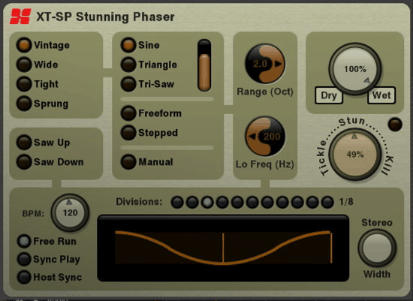XT-SP “Stunning Phaser” is a creative modulation effect similar to the classic Phaser guitar effect.
Unlike a traditional phaser, where the modulation is free-running, the XT-SP provides multiple methods to sync the modulation LFO to the session’s playhead position. This makes it particularly useful as a production & mixdown effect, because it always sounds the same.
Best when used on: Vocals, Guitars, Drums and Keyboards…. or anything that needs a bit of funk-ifying!

Controls:
Selecting various modes will enable/disable the associated controls, depending on their applicability.
Modes: Select one of 4 main modes:
- Vintage: A single sharp peak and 2 notches. Traditional, clean guitar-pedal sound.
- Wide: Several widely-spaced peaks and notches. A more complicated, but still clean sound.
- Tight: Several tightly-spaced peaks and notches. A dense and complicated sound.
- Sprung: In Sprung mode, the peaks and notches move faster as the frequency increases.
Oscillator Shape: select the modulation type:
- Sine: has a “dwell” time at the upper and lower limits. Adjust the vertical “shape” slider to increase the steepness of the sine wave until it reaches a square wave.
- Triangle: the most common repeating-cycle shape for a phaser effect. Adjust the “shape” slider to morph the triangle shape.
- Tri-Saw: Similar to the Triangle wave, but adjusting the “shape” slider will tilt the shape into a sawtooth.
- Freeform: In freeform mode, the user is presented with sliders for 8 steps in the oscillator cycle. The “shape” slider is disabled.
- Stepped: in this mode, the user is presented with sliders for 8 steps in the oscillator cycle. The “shape” slider is disabled.
- Manual: in this mode, the user must adjust the “Base Freq” control manually, or automate it using Mixbus’s automation features.
Frequency Knobs:
Range: this is the sweep-range of the effect, in octaves.
Base Freq: this is the lowest frequency that the sweep will reach. Frequencies below here will not be strongly affected.
Barberpole modes: These modes use a sawtooth modulator shape, either climbing or descending. But there is no discontinuity when the sawtooth resets; the peaks and notches continuously cycle like a rotating barberpole. The resulting effect is good for applying a subtle downward or upward-spiraling effect durin mixdown. Or with more aggressive settings, it can apply an envelope-filtered sound. When a barberpole mode is selected, the Oscillator knobs will be disabled.
BPM: the BPM knob is used to set the rate of the oscillator.
- Free Run: in Free Run, the oscillator runs at the defined BPM, like a standalone guitar pedal.
- Sync Play: in this mode, the oscillator uses its own BPM setting, but it calculates the oscillator position from the host timeline; so repeated playback will always sound the same.
- Host Sync: in this mode, the oscillator always follows the exact position and tempo of the host’s timeline (“Hard Sync”)
Oscillator Display: this display shows the oscillator shape, as well as a vertical line representing the current position of the oscillator value. Click & drag on the oscillator display to adjust the “phase offset* of the oscillator. This allows you to synchronize the modulation to emphasize a particular rhythmic pulse in the plugin’s input signal.
Stereo Width: If the Stereo version is used on a track, then the display provides 2 different lines, and a “stereo width” knob which varies the distance between the 2 lines. For a dramatic stereo effect, use a very small distance between the 2 lines.
Divisions: Each LED indicator represents a different subdivision of the base tempo. Use these settings to increase or decrease the oscillator speed, while matching the tempo to the music. Select different ratios (1/12 or 2/3 on a 4/4 meter) to create polyrhythms in the modulation.
Wet/Dry knob: Turning this knob to the left will result in a 100% Dry sound (no effect is heard). Turning the knob to the right will result in 100% Wet sound (no dry signal is heard). A momentary button for ‘Dry’ and ‘Wet’ allows you to audition the effect without permanently changing the knob setting.
Regeneration: Perhaps the most important knob, the regeneration (sometimes called feedback or resonance) controls the sharpness of the filters by sending the signal through the filter multiple times. Increase the regeneration knob for wild synth-like effects. The red light will indicate when the phaser feedback path is saturated.


Post your comment on this topic.